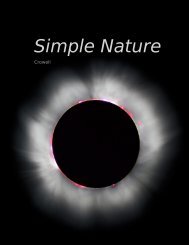The size of a radio antenna is closely related to ... - Light and Matter
The size of a radio antenna is closely related to ... - Light and Matter
The size of a radio antenna is closely related to ... - Light and Matter
You also want an ePaper? Increase the reach of your titles
YUMPU automatically turns print PDFs into web optimized ePapers that Google loves.
g / Three types <strong>of</strong> transformations that preserve parallel<strong>is</strong>m. <strong>The</strong>ir<br />
d<strong>is</strong>tingu<strong>is</strong>hing feature <strong>is</strong> what they do <strong>to</strong> simultaneity, as shown by what<br />
happens <strong>to</strong> the left edge <strong>of</strong> the original rectangle. In I, the left edge<br />
remains vertical, so simultaneous events remain simultaneous. In II, the<br />
left edge turns counterclockw<strong>is</strong>e. In III, it turns clockw<strong>is</strong>e.<br />
h / In the units that are most<br />
convenient for relativity, the transformation<br />
has symmetry about a<br />
45-degree diagonal line.<br />
i / Interpretation <strong>of</strong> the Lorentz<br />
transformation. <strong>The</strong> slope indicated<br />
in the figure gives the<br />
relative velocity <strong>of</strong> the two frames<br />
<strong>of</strong> reference. Events A <strong>and</strong> B that<br />
were simultaneous in frame 1<br />
are not simultaneous in frame 2,<br />
where event A occurs <strong>to</strong> the right<br />
<strong>of</strong> the t = 0 line represented by<br />
the left edge <strong>of</strong> the grid, but event<br />
B occurs <strong>to</strong> its left.<br />
portional <strong>to</strong> v, then for large enough velocities the grid would have<br />
left <strong>and</strong> right reversed, <strong>and</strong> th<strong>is</strong> would violate property 4, causality:<br />
one observer would say that event A caused a later event B, but<br />
another observer would say that B came first <strong>and</strong> caused A.<br />
<strong>The</strong> only remaining possibility <strong>is</strong> case III, which I’ve redrawn<br />
in figure h with a couple <strong>of</strong> changes. Th<strong>is</strong> <strong>is</strong> the one that Einstein<br />
predicted in 1905. <strong>The</strong> transformation <strong>is</strong> known as the Lorentz<br />
transformation, after Hendrik Lorentz (1853-1928), who partially<br />
anticipated Einstein’s work, without arriving at the correct interpretation.<br />
<strong>The</strong> d<strong>is</strong><strong>to</strong>rtion <strong>is</strong> a kind <strong>of</strong> smooshing <strong>and</strong> stretching,<br />
as suggested by the h<strong>and</strong>s. Also, we’ve already seen in figures a-c<br />
on page 385 that we’re free <strong>to</strong> stretch or compress everything as<br />
much as we like in the horizontal <strong>and</strong> vertical directions, because<br />
th<strong>is</strong> simply corresponds <strong>to</strong> choosing different units <strong>of</strong> measurement<br />
for time <strong>and</strong> d<strong>is</strong>tance. In figure h I’ve chosen units that give the<br />
whole drawing a convenient symmetry about a 45-degree diagonal<br />
line. Ordinarily it wouldn’t make sense <strong>to</strong> talk about a 45-degree<br />
angle on a graph whose axes had different units. But in relativity,<br />
the symmetric appearance <strong>of</strong> the transformation tells us that space<br />
<strong>and</strong> time ought <strong>to</strong> be treated on the same footing, <strong>and</strong> measured in<br />
the same units.<br />
As in our d<strong>is</strong>cussion <strong>of</strong> the Galilean transformation, slopes are<br />
interpreted as velocities, <strong>and</strong> the slope <strong>of</strong> the near-horizontal lines<br />
in figure i <strong>is</strong> interpreted as the relative velocity <strong>of</strong> the two observers.<br />
<strong>The</strong> difference between the Galilean version <strong>and</strong> the relativ<strong>is</strong>tic one<br />
<strong>is</strong> that now there <strong>is</strong> smooshing happening from the other side as<br />
well. Lines that were vertical in the original grid, representing simultaneous<br />
events, now slant over <strong>to</strong> the right. Th<strong>is</strong> tells us that, as<br />
required by property 5, different observers do not agree on whether<br />
events that occur in different places are simultaneous. <strong>The</strong> Hafele-<br />
Keating experiment tells us that th<strong>is</strong> non-simultaneity effect <strong>is</strong> fairly<br />
small, even when the velocity <strong>is</strong> as big as that <strong>of</strong> a passenger jet,<br />
<strong>and</strong> th<strong>is</strong> <strong>is</strong> what we would have anticipated by the correspondence<br />
principle. <strong>The</strong> way that th<strong>is</strong> <strong>is</strong> expressed in the graph <strong>is</strong> that if we<br />
388 Chapter 7 Relativity














